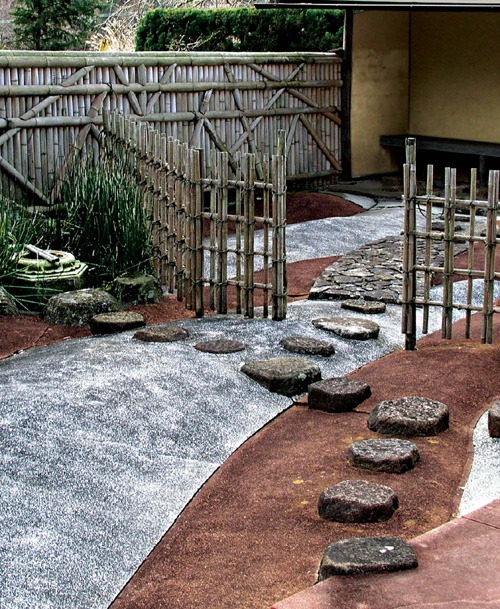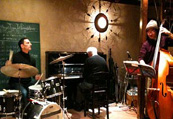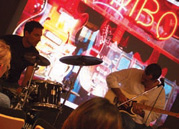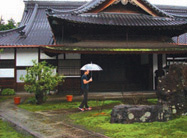Authors: Garr Reynolds
Presentation Zen: Simple Ideas on Presentation Design and Delivery, 2nd Edition (Ira Katz's Library) (38 page)

...your room will quickly begin to look like this.
When you truly engage someone in a presentation, you can awaken something inside them. Benjamin Zander, introduced in
Chapter 8
, is the master of awakening the possibilities in others. And awakening the possibilities in others—our students, colleagues, audiences, etc.—is exactly what he urges us to do as well. After all, what is the role of a good leader if not to awaken the possibility of a group, organization, or even nation? What is the role of a good teacher if not to inspire and awaken the potential of each student? Is not the role of a good parent—among a million other things—to awaken the possibilities within each of their children? Obviously not every presentation is an opportunity to inspire in a big way, but we need to affect a change in people, and that involves engaging them and awakening them to new possibilities.
How do you know if you are awaking the possibility in each student or audience member, Ben asks. The answer? “Look at their eyes. If their eyes are shining, you know you’re doing it.” He goes on to say, “If the eyes are not shining you have to ask yourself a question: Who am I being that my players’ eyes are not shining?” This goes for our children, students, audience members, and so on. For me, that’s the greatest takeaway question: Who am I being when I am not seeing a connection in the eyes of others?
• Engagement invloves tapping the audience members’ emotions.
• Keep the lights on; the audience must always be able to see you.
• Remove any barriers between you and the audience. Avoid podiums and lecterns, if possible.
• Use a wireless mic and remote control for advancing slides so you can move around freely and naturally.
• Be positive, upbeat, humorous, and develop rapport with the audience. You must believe in your content or you cannot sell it.


What we think, we become.
—Buddha

Many people look for the short road and the quick fix to achieve presentation excellence. But it doesn’t exist—there are no panaceas or off-the-shelf fixes. Learning to become an exceptional presenter in today’s world is a journey. This journey offers many paths to presenting in a more enlightened way, a way that is appropriate for the world in which we live. The first step down the road to becoming a great presenter is simply seeing—really seeing—that what passes for normal, ordinary, and good enough is off-kilter with how we learn, understand, remember, and engage.
No matter what your starting point is today, you can become much better. In fact, you can become extraordinary. I know this is true because I have seen it many times before. I have worked with professionals—young and old—who believed they were not particularly creative, charismatic, or dynamic. And yet, with a little help, they were able to transform themselves into extremely creative, highly articulate, engaging presenters once they realized that a remarkable presenter was inside them already. Once they opened their eyes and made the commitment to learn and leave the past behind, it was just a matter of time before great progress was visible. Interestingly, as their confidence grew and they became more effective presenters, their newly found confidence and perspective had a remarkable impact on other aspects of their personal and professional lives.
There are many things you can do to become a better presenter—with or without the use of multimedia—and a better, more effective communicator in general. The following are just a few things to keep in mind.
Through books, DVDs, and myriad online resources, you can teach yourself much of what you need to be an exceptional presenter. On my website,
www.presentationzen.com
, I recommend many books, DVDs, and websites related to presentation design and delivery. Most of the items I recommend are not necessarily about presentation skills or slideware. However, these are the resources that are often the most helpful. For example, you can learn a lot about storytelling and the use of imagery by studying the masters of documentary film and cinema. Even books on writing screenplays offer lessons you can apply to the world of presentations. You just never know what you’ll learn through self-study, especially when you look in unusual places.
Reading and studying are important and necessary, but to really get better at presenting—including designing the visuals—you have to actually
do it
, and do it often. So look for opportunities to present. If there is a local Toastmasters (
www.toastmasters.org
) chapter in your area, consider getting involved. Better yet, look for a local TEDx event (
www.ted.com/tedx
), PechaKucha Night (
www.pecha-kucha.org
), or Ignite event (ignite.oreilly.com). If you don’t find one of these events in your area, then why not start one? Volunteer to present for your school, business, or user group, and look for other opportunities to “give it away” and make a contribution by sharing your information, skill, or story through a presentation in your community.

Finding inspiration in jazz...
It’s important for working professionals—no matter their field—to stay in touch with and nurture their creative soul. What a waste it would be to ignore one of your passions or talents. Frankly, you just never know where inspiration will come from. Inspiration, clarity, or a new perspective may materialize unforced as you climb a mountain, paint a portrait, photograph a sunset, write a novel...or find your groove while playing with fellow musicians in a downtown nightclub (or garage).
I no longer play music full time, but I still perform occasionally with local jazz and blues musicians in nightclubs around Osaka. It’s so good for the creative spirit to play live and connect with other musicians and with appreciative audiences. Jazz and the blues especially are about connecting and telling a story through the lyrics and music. It’s about feelings. Playing the blues or jazz well is similar to making great presentations—it’s not about technique. Once you begin to focus on technique, tricks, flash, and making an impression, all is lost. If I never played music, I would miss all those lessons.

...and the blues...
Nothing great will ever happen to you if you stay in your comfort zone. So as much as you can, get out of your office or school or house and make connections. Look to exercise the right (creative, emotional) side of your brain. “Out there” is where the learning occurs. Challenge yourself and develop your creativity; exercise your creative brain. Take a drama class. Take an art class. Enroll in a seminar. Go to a movie. Go to a concert. Go to a play or a musical. Or just go for an inspirational walk alone.

...and visiting a temple in Kyoto.
We can find inspiration and lessons in unexpected places. For example, over the years I’ve learned a lot about graphic design—what’s effective and what’s not—during the morning commute on the trains. Trains in Japan are clean, comfortable, and on time. The trains are also full of print advertising hanging from and affixed to every conceivable space. I enjoy scanning the print ads while I commute as it gives me a chance to keep abreast of new products and events while also studying graphic design trends and observing the way graphics are used in print media.
You can learn a lot about fundamental design principles and develop a critical eye through careful examination of the graphic design found in posters, banners, street signs, storefronts, and so on. We usually ignore or take for granted so much of the design in urban settings, but just walking down the street you’ll find that the examples from which to learn are all around you. The lessons are everywhere. It’s just a matter of seeing.

